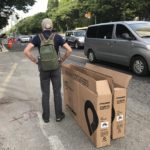Busan
Our stay at Haeundae Beach did not permit any beach time, alas. The first day was rainy, so we spent the time doing laundry and planning ahead. We did have pleasant strolls along the beach front, however. Yesterday, we took the subway into the city to tour the high-end Lotte Department Store and Jagalchi fish market. We recalled the lively atmosphere of the market from when we had visited with Chris, in 2009. There is a an overwhelming abundance and variety of fish and seafood to choose from, all so attractively displayed. The vendors will cook for you to eat on site. We chose fresh grilled pollack, which was served with rice and banchan.
As much as we would have loved to spend more time in the market and shopping, we were preoccupied with acquiring bags to pack up our bikes for the ferry to Japan. With the help of our hotel, we had learned that the overnight ferry onto which we could have ridden our bikes does not start up again until May 30. The available faster boat requires that our bikes be packed as cargo. We searched for Japanese “Rinko” bags, but they do not seem to be available here or would have to be ordered. At the fourth bike store we visited, we were given discarded cardboard bike boxes. We don’t know whether these will be acceptable at the ferry terminal. Standing out on the street, waiting to flag down a cab to take us and the two boxes back to the hotel, Lois was skeptical that anyone would stop. Happily, a helpful taxi driver pulled up, instructed Paul to get in the back seat and then promptly wedged the two boxes in on top of him, much to the amusement of Lois and the driver!
Parkinson’s Disease Note:
Our efforts to contact officials in South Korea to discuss rehabilitation programs and PD were ultimately unsuccessful. Nor have we come across any studies on this aspect of PD.
Our efforts to contact officials in South Korea to discuss rehabilitation programs and PD were ultimately unsuccessful. Nor have we come across any studies on this aspect of PD.
One study concluded that the the prevalence of PD in South Korea is similar to that of Western countries (Prevalence of Parkinson’s disease in Korea. Seo WK, et al. J Clin Neurosci. 2007). Another study showed that major difficulties experienced by PD patients were physical (67%), psychiatric (60%) but severe difficulties were also experienced socio-economically; 52% in patients and 49% in caregivers, especially among patients in their fifties (58%) and those with their spouse (65%) as caregivers. The topmost need was the need to pay for new treatments for PD (62%), followed by relief of costs for other treatment (38%) and a family support system (31%).
(J Mov Disord 2017; 10(3): 109-115.
Patients and Their Caregivers’ Burdens for Parkinson’s Disease in Korea
Jong SB et al).
Also of note is that in one study, ninety-four (76%) patients in South Korea had used complementary or alternative medicine (CAM). The mean cost of CAM paid by patients (out-of-pocket costs) was 102.3 US Dollars (USD) per month, while medical costs of treatment for PD paid by patients (out-of-pocket costs) averaged 72.8 USD per month. The spectrum of CAM use included oriental medicines (76.6%), traditional food (44.7%), non-prescribed drugs (31.9%), traditional therapies (7.4%), massage (7.4%) and behavioral therapy (7.4%). The author suggested that the results show that a high proportion of Korean PD patients employed CAM, associated with high costs and serious side effects in some patients, although not having access to the complete article it was not possible to get an explanation for this statement (Use of complementary and alternative medicine by Korean patients with Parkinson’s disease.
Kim SR, et al. Clin Neurol Neurosurg. 2009).
(J Mov Disord 2017; 10(3): 109-115.
Patients and Their Caregivers’ Burdens for Parkinson’s Disease in Korea
Jong SB et al).
Also of note is that in one study, ninety-four (76%) patients in South Korea had used complementary or alternative medicine (CAM). The mean cost of CAM paid by patients (out-of-pocket costs) was 102.3 US Dollars (USD) per month, while medical costs of treatment for PD paid by patients (out-of-pocket costs) averaged 72.8 USD per month. The spectrum of CAM use included oriental medicines (76.6%), traditional food (44.7%), non-prescribed drugs (31.9%), traditional therapies (7.4%), massage (7.4%) and behavioral therapy (7.4%). The author suggested that the results show that a high proportion of Korean PD patients employed CAM, associated with high costs and serious side effects in some patients, although not having access to the complete article it was not possible to get an explanation for this statement (Use of complementary and alternative medicine by Korean patients with Parkinson’s disease.
Kim SR, et al. Clin Neurol Neurosurg. 2009).









Ha!Ha! And we’re worried about having one bike box!
That was not the end of it! The next post, coming soon, will tell the tale.